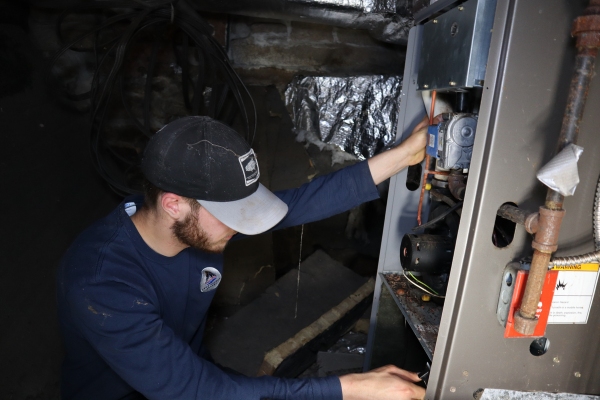Table of Contents
- Understanding the Basics of Furnace Ignitors
- What a Furnace Ignitor Does
- Signs Your Heating System Ignitor May Not Be Working
- How to Check If the Heater Ignitor Is Working
- Why Professional Furnace Repair Service Matters
- FAQs: Gas Furnace Ignitor Not Working
- Conclusion
- Contact Lake Region Energy for Trusted HVAC Services
When the temperature drops and your home depends on steady heat, a sudden furnace issue can be unsettling. One of the most common causes of failure is the gas furnace ignitor not working, which prevents the system from starting and leaves the air cold.
At Lake Region Energy, we know how critical every part of your heating system is for comfort and safety. The ignitor, though small, plays a vital role in lighting the burners and keeping your furnace running.
This article explains how a furnace ignitor functions, the warning signs of failure, safe ways to test it, and when to call a professional for expert service.
Keep Your Home Warm All Winter: Trust Lake Region Energy for expert heating services. Call now to schedule an appointment!
Understanding the Basics of Furnace Ignitors

A furnace ignitor starts the heating process by lighting the gas burners, making it essential to system performance. Understanding how it works provides the foundation for recognizing problems and knowing when service is needed.
Enjoy Reliable Comfort Every Day: Let Lake Region Energy handle all your heating needs. Call today!
What a Furnace Ignitor Does
The furnace ignitor is the component that ignites the natural gas or propane supplied to the burners, beginning the heating cycle. The furnace generates and distributes warm air throughout the home by creating a flame that warms the heat exchanger.
A properly functioning ignitor allows the system to start quickly and run efficiently, helping maintain steady comfort while keeping fuel use under control. If the ignitor fails, the burners will not light, and the furnace may continue cycling without producing heat, leaving the home cold and forcing the system to work harder without success.
Types of Furnace Ignitors
Furnace ignitors come in two main designs, each with a different way of starting the heating process.
- Hot Surface Ignitors: Common in modern furnaces, these use an electrical current to heat a ceramic surface until it glows orange, directly igniting the gas. They operate quietly and efficiently but are delicate, making them prone to cracking and eventual failure.
- Spark Ignitors: These create a small electrical spark, much like a gas stove, to ignite the fuel. They are more durable than hot surface models, though electrode wear or debris buildup can interfere with sparking over time.
Stay Cozy When It Matters Most: Count on Lake Region Energy for dependable HVAC care. Reach out now!
Signs Your Heating System Ignitor May Not Be Working
When the ignitor begins to fail, the furnace often shows clear warning signs that should not be ignored.
No Heat Production

If the ignitor fails, the furnace may turn on but only push cold air through the vents. This is often the first and most noticeable symptom of a gas furnace ignitor not working.
Furnace Short Cycling
A failing ignitor can cause the system to start and then shut down quickly before completing the heating cycle. This wastes energy and unnecessarily strains other components.
Lower Your Energy Bills: Improve efficiency with professional heating services from Lake Region Energy. Call today to learn more!
Strange Heating System Sounds

Clicking, humming, or repeated ignition attempts suggest the ignitor is struggling to light the burners. These sounds signal that the system is trying to start but cannot complete the ignition process.
Physical Damage
Hot surface ignitors are fragile and may crack, while spark ignitors can wear down or become coated with buildup. Any visible damage is a clear sign that the part may need replacement.
Blower Running Continuously
Sometimes the blower continues operating even though the burners never ignite. This occurs because the furnace cycles air without producing heat, leaving the home uncomfortable.
Smart Heating Solutions That Last: Save money and stress with trusted service from Lake Region Energy. Call today!
How to Check If the Heater Ignitor Is Working

Watch for signs that the ignitor is activating when the furnace starts its cycle. A hot surface ignitor should glow bright orange, while a spark ignitor should produce a visible spark near the burners. Once the ignitor engages, you should hear the gas ignite. If the furnace does not light, the ignitor may be failing.
Another sign to look for is how the flame sensor responds. If the ignitor works correctly, the flame sensor detects the flame and allows the furnace to keep running. If the system shuts down shortly after startup, the ignitor could be at fault.
Ignitors are delicate parts that can easily break or wear out. Oils from your fingers can damage hot surface ignitors, and physical contact often leads to cracks. For this reason, homeowners should avoid handling them directly. If an ignitor shows damage or the furnace continues to fail during startup, calling a trained professional is the safest way to resolve the issue.
Protect Your Budget With Preventive Care: Lake Region Energy helps stop small heating issues before they grow. Call us today!
Why Professional Furnace Repair Service Matters
Furnace ignitors are delicate and require precise handling to avoid damage. A professional technician has the tools to test the part with a multimeter, confirm whether it is failing, and install the correct replacement model safely.
During service, HVAC technicians also examine related components such as the gas valve, control board, and flame sensor to ensure the entire ignition system operates properly. Relying on professional care helps protect your furnace from further issues, restores safe operation, and ensures dependable heating performance.
When to Seek Professional Assistance

If your furnace continues to show problems after basic checks, it is time to involve a trained technician.
- No Ignition at All: If the ignitor does not glow or spark during startup, it is likely failing and may need replacement.
- Gas Doesn’t Ignite: When the ignitor activates but the gas will not light, the problem may involve the gas valve or another critical furnace component.
- Frequent Cycling: If the furnace starts and stops repeatedly, a professional can identify whether the cause is the ignitor, the control board, or a sensor issue.
Peace of Mind All Season Long: Depend on Lake Region Energy for safe, reliable heating solutions. Call now!
FAQs: Gas Furnace Ignitor Not Working

How Long Does a Furnace Ignitor Usually Last?
Most furnace ignitors last between 3 and 7 years. The exact lifespan depends on how often your furnace cycles, the quality of the part, and how well your furnace is maintained. Frequent on-and-off cycles cause the ignitor to heat up and cool down more often, which wears it out faster. Power surges and dust buildup can also shorten its lifespan. Regular furnace maintenance helps extend the ignitor’s life.
Can a Multimeter Be Used to Test an Ignitor?
Yes, a multimeter is one of the most reliable ways to check if an ignitor is still functional. A technician measures resistance across the ignitor terminals. A reading that’s too high or too low indicates the part is faulty. For safety, this test should be done with the furnace powered off. While homeowners with electrical experience sometimes attempt this, it’s safest to leave the process to a professional who knows the correct resistance ranges for different ignitor types.
Why Does the Furnace Blow Cold Air if the Ignitor Fails?
If the ignitor doesn’t work, the furnace never lights the gas, which means the blower fan ends up circulating unheated air. Some furnaces also run the fan as part of their ignition sequence, so you may notice cold air blowing right before the system shuts down. If this happens repeatedly, it’s a strong indicator that the ignitor, or another ignition-related component, is failing.
Your Local Heating Experts: From repairs to inspections, Lake Region Energy has you covered. Call today!
Is It Safe to Replace a Furnace Ignitor Myself?
Ignitors are fragile and easy to damage, so while it’s possible to replace one yourself, it’s not recommended. Incorrect handling can break the part, and improper installation can damage the furnace or create safety hazards. Professionals ensure the right ignitor is installed, test the system after replacement, and check for other issues like gas leaks or faulty sensors. Choosing expert service ensures both safety and long-term reliability.
How Is an Ignitor Different From a Pilot Light?
Older furnaces use a pilot light, or the small flame that stays lit continuously, to ignite the burners. Modern furnaces, however, use electronic ignitors that only activate when the furnace starts up. This makes ignitors more efficient because they don’t waste gas keeping a flame burning all the time. Ignitors are also safer because they eliminate the risk of a pilot light going out and allowing gas to leak into the home.
Conclusion
The furnace ignitor may be small, but it is essential to your heating system’s operation. If it fails, the burners cannot light, leaving your home without heat. Recognizing symptoms such as short cycling, strange noises, or a blower running without warmth can help you identify problems early. Safe checks, like observing for a glow or spark, provide useful clues, but ignitor replacement should be left to trained experts.
If your gas furnace ignitor is not working, contact Lake Region Energy. Our technicians will diagnose the issue, replace damaged parts, and restore your system to safe, efficient performance.
Expert Heating Service You Can Rely On: Lake Region Energy keeps your system running smoothly. Call now for professional care!
Contact Lake Region Energy for Trusted HVAC Services
Lake Region Energy provides dependable heating and cooling solutions throughout Maine and New Hampshire. Our professionally certified technicians specialize in tune-ups, repairs, installations, replacements, and more. With extensive training and hands-on experience, we ensure your system receives precise and reliable care every time.
We are dedicated to offering some of the most competitive rates for HVAC services in the region. Our professional services are designed to improve comfort, enhance efficiency, and reduce energy costs.
Whether you need a fast repair or a full system upgrade, Lake Region Energy will recommend solutions tailored to your home and budget. Every job we handle is backed by a strong satisfaction guarantee.
Call Lake Region Energy today to schedule your service appointment and request an in-home consultation. Call now!
For more information about our HVAC services and fuel deliveries, be sure to contact Lake Region Energy. You can click here to contact us, or you can call us at (207) 839-5500 to find out more. We offer a full line of heating and cooling repairs, maintenance services, and installations. Click the link to view our service area.

Related Articles:
